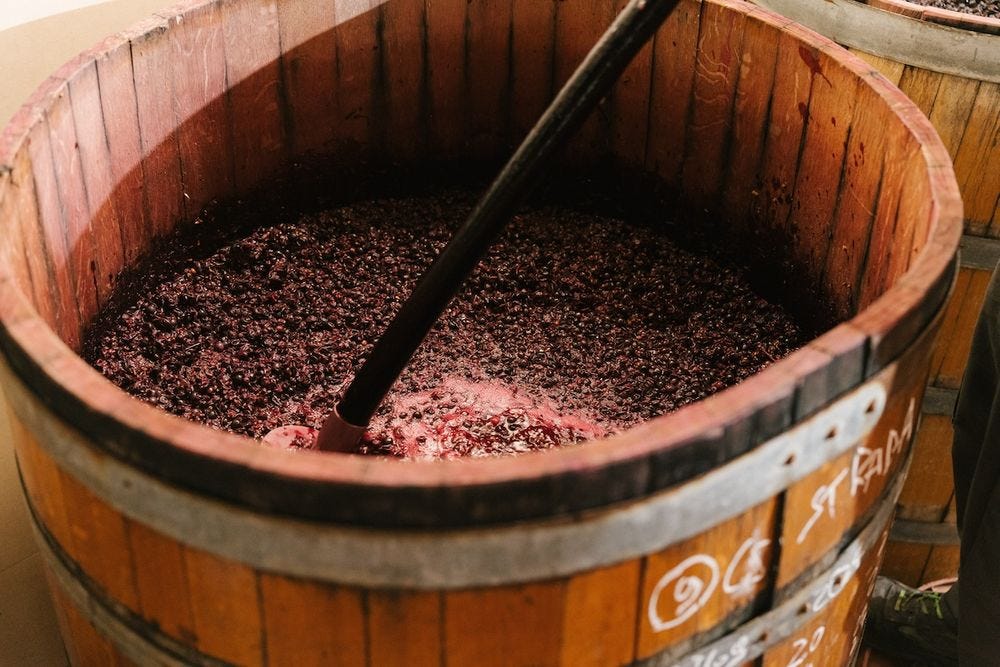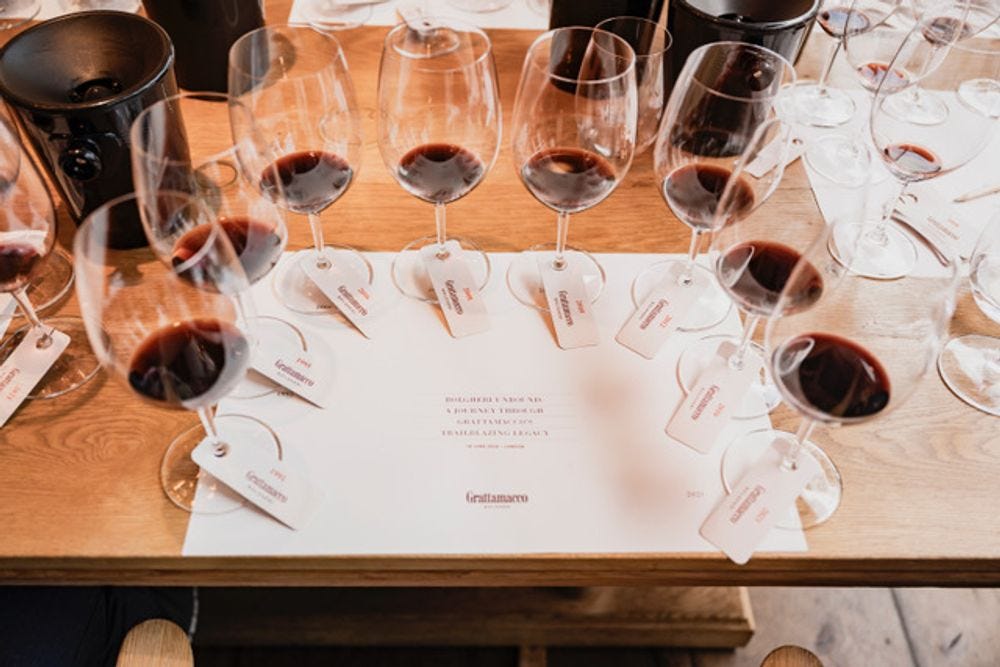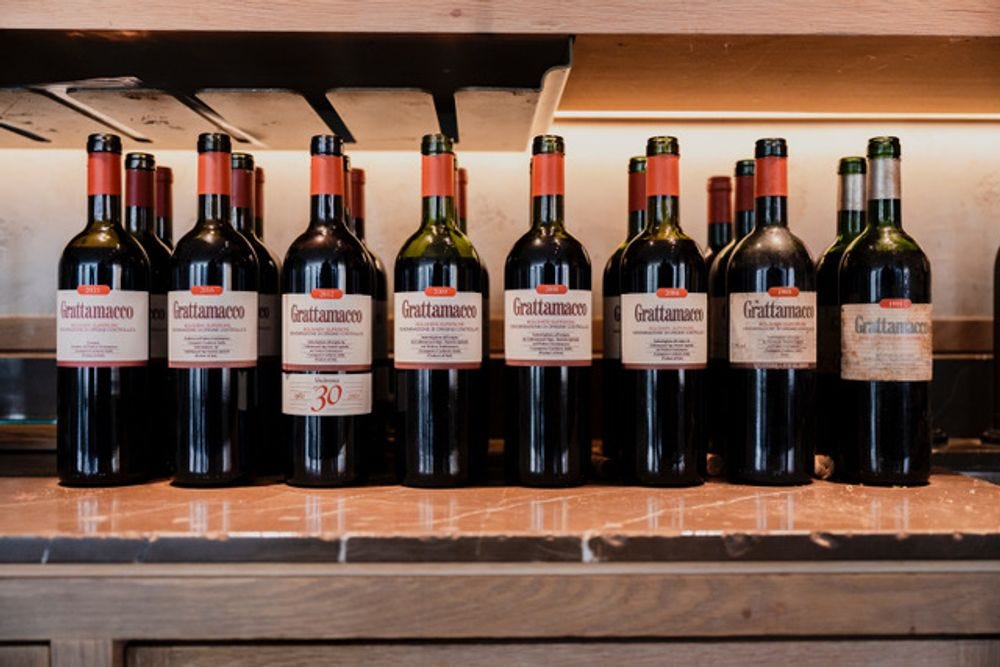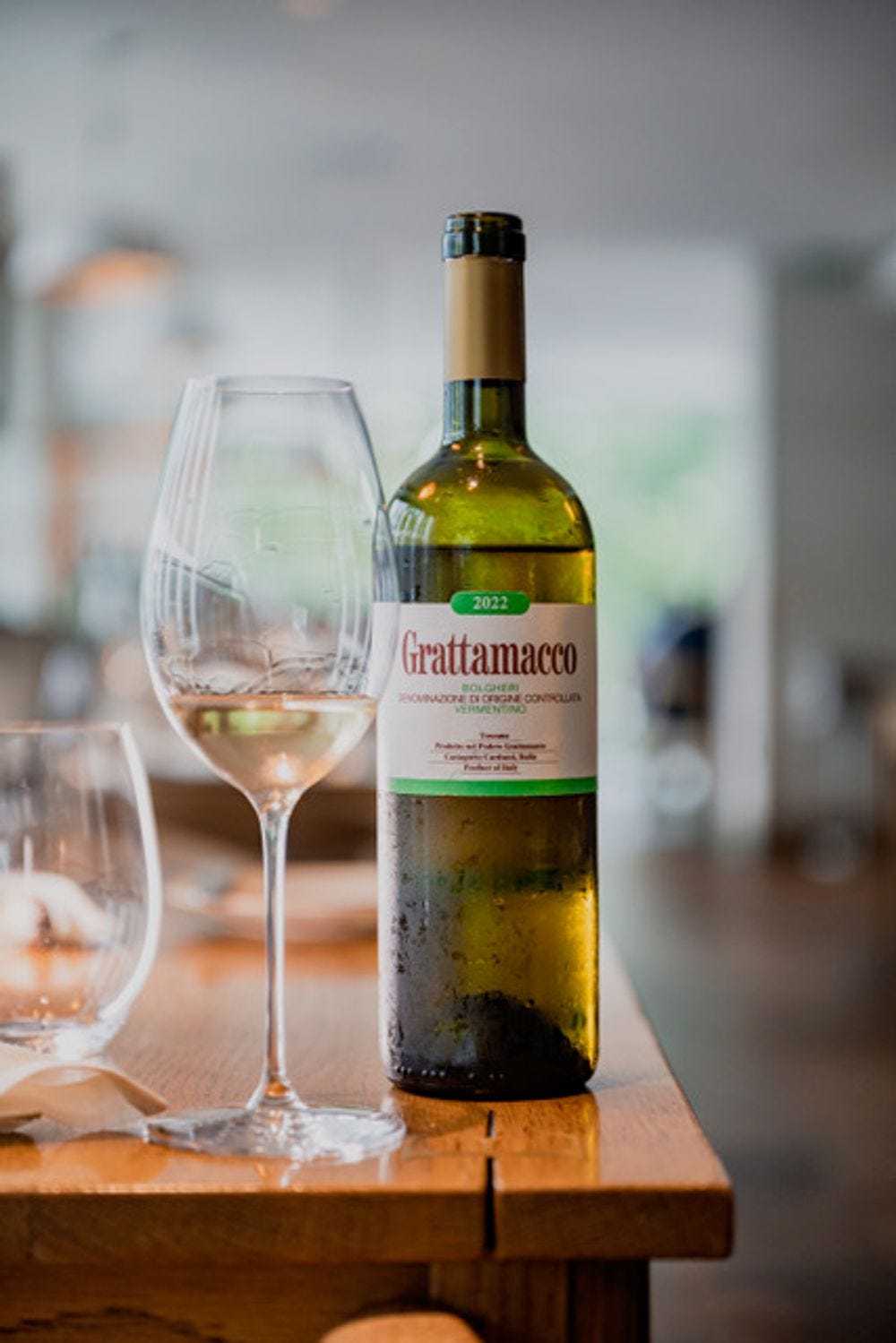Grattamacco: A Bolgheri Icon
An in-depth tasting back to 1991 shows the evolution and innovation of this influential estate on the Tuscan coast
Situated up the higher altitude reaches of Bolgheri, nestled among copious woods and craggy, forested hills, Grattamacco is a winery that stands apart from other estates in the region.
It was the second winery to be founded in Bolgheri in 1977, with wines produced from 1979 and commercially released with the 1982 vintage. Just as Sassicaia is named after the stones of the vineyard, Grattamacco is named after the rock scrapings (‘gratta’) discarded by the ancient Etruscans when they were smelting iron (“macco”). It’s an unromantic name, a reminder that this rough-hewn land wasn’t always home to well-manicured vineyards and beach-front restaurants, and that breaking rocks and forging metal were once more essential activities.
Perhaps the estate’s isolation encourages independent thinking. Of course there are French varieties, but there has always been some Sangiovese planted, which is not really the brand identity of Bolgheri. Even when wineries are turning away from Merlot due to changes in climate, they are looking to Cabernet Franc, not Sangiovese, and Cabernet Sauvignon remains king.
There’s some old school winemaking too — punchdowns by hand, spontaneous open-top fermentation in tinelli and dramatically long periods of skin contact that seem almost out of place in the internationally glamorous land of the Super Tuscans. In some ways, Grattamacco seems like it would be more at home among the Montevertines and Mascarellos of the wine world than with Cabernet Sauvignon and barriques.
Yet Grattamacco is foundational for modern, Médoc-inspired Bolgheri. It was here in 1994 that Bolgheri DOC finally welcomed red wines into the fold under the Bolgheri Superiore DOC classification. Under a tree in the Grattamacco courtyard, a sort of Tuscan Yalta Conference happened that year, bringing together Grattamacco’s Piermario Meletti Cavallari, Sassicaia’s Nicolò Inciso della Rocchetta, Piero Antinori of Guado al Tasso, Ludovico Antinori of Ornellaia, and Michele Satta.
At a recent tasting at Hide restaurant in London, Grattamacco celebrated 30 years of Bolgheri Superiore. Chief winemaker Luca Marrone and chief executive Giuseppe Di Gioia were at pains to stress that the estate has come a long way by doing its own thing and evolving its own style, making it something of a pioneer and a free thinker in a region that can seem heavily indebted to red Bordeaux.
Grattamacco’s founder, Piermario Melleti Cavallari, was inspired by the influential writer and journalist Luigi Veronelli to leave a career in management and make wine. His first commercial vintage was 1982. When he bought the estate, there were three hectares of Sangiovese and Trebbiano in the ground. As early as 1986, the humdrum Trebbiano was grubbed up and Vermentino planted from a massal selection of local old vines, making it now the oldest Vermentino in the region. It was a pioneering and foresightful decision, vindicated by history.
Meletti Cavallari planted Cabernet Sauvignon, inspired by Sassicaia, and adopted wild yeast ferments and the 700-litre tinelli barrel for fermentation on the same basis. In those early years, Sangiovese played a larger role than Cabernet Sauvignon. In 1982, it formed the majority of the blend, ceding ground gradually to Cabernet Sauvignon over the 1980s, until, between 1990 and 1994, it formed just half the blend alongside Cabernet.
But Sangiovese was never entirely usurped. It benefitted from the drier growing season and Grattamacco’s position at altitude, which reduces disease pressure on Sangiovese and allows it a longer growing season. But although it was the historical variety of the area, Cabernet was better suited to the lower altitudes and coastal climate. “It is more sensitive to the terroir,” Marrone says.
It was in 1995 that Merlot finally came into the Bolgheri Superior of Grattamacco, forming the trinity that would carry the wine through the next three decades: 65% Cabernet Sauvignon, 20% Merlot and 15% of Sangiovese, allowing for certain variations vintage to vintage. Will Sangiovese return?
Not imminently, Marrone says. “For the moment we'd like to preserve the original classical proportion of the varieties, with Sangiovese at 15%, but nothing is to be excluded in the future.”
In the late 1990s, Grattamacco became organic. With its hilly location and cleansing winds, it suffered less from dampness than the proprietors on the coast, making organic viticulture a viable choice. Again, where Grattamacco had led, others followed – eventually.
By 1998, the company had acquired Casavecchia, a relatively high altitude vineyard (220m) planted with Merlot, which is, even in the climate change era, harvested relatively late.
“Casavecchia is one of the last vineyards that we pick in a vintage, after we have picked the Cabernet Sauvignon. It is in the north so the ripeness is low. Usually, it's the best Merlot that we have,” says Marrone. “It was a good decision and now important producers from the area are following us,” adds chief executive Giuseppe di Goia.
In 2002, Piermario sold up to his friend Claudio Tipa, owner of the Colle Massari estate in Montecucco. Marrone was the winemaker there at the time and he recalls being given 24 hours notice that he was to go to Grattamacco to help out in the middle of the torrid 2003 harvest. It was so hot that some of the younger Merlot vines on the property had potential alcohols of 20%.
“We made it into brandy for the family,” he says.
His contribution to the development of Grattamacco has been refinement of practice, particularly on the viticultural side, increasing quality in the grand vin, the Bolgheri Superiore. This was achieved by increasing the number of pickings in the vineyard and performing a stricter selection of fruit.
“Before I arrived, we made twice as much Bolgheri Superiore as Bolgheri Rosso. Now it is the other way around.”
Vineyard mapping was undertaken and experiments with now-fashionable Cabernet Franc began. Two hectares of Cabernets Sauvignon and Franc were planted to bush vines in 2004, another modern trend that Grattamacco anticipated by at least a decade. Their field-blended fruit is now bottled under the L’Alberello label. Bush vine planting has been incorporated in the DOC disciplinare as a result – another contribution to the wider region from Grattamacco.
Marrone also tweaked the oak regime, decreasing the amount of new oak but extending the maturation. In the 1990s the wine was usually aged for 12 months and the new oak could range from 30% to 50%. From 2000 to today, that has decreased to around 30-40%, depending on the vintage, while the ageing period has increased to 18 months on average. Given the legacy of many of Bolgheri’s wines to maximise oak, ripeness and extraction, Grattamacco has shown a certain wisdom and discretion in its use of the barrel that has proven foresightful in an era when such overblown wines are regarded as dated.
Changing Tastes
As we taste through, starting with 1991, Marrone reflects that 2006 was the last of what he calls the classic vintages and the beginning of the new vintages – namely those marked by more heat, drought and unpredictability.
“For example, in 2009, 2012, or 2016 we had a hotter, warmer temperature during the summer that changed the biochemicals of the grapes. But luckily, you can get some rain at the right moment, which is a blessing for this kind of vintage.”
This kind of harvest has now become typical for the estate.
All the wines on show demonstrated Grattamacco’s hallmarks of definition and a certain finesse. This is aided in warmer vintages by a technique called piemontesinawhereby the tanks are topped right up at the end of fermentation to prevent any oxygen ingress and the wine then left on the skins until the following spring, or later.
“The first time that we used this technique was for the 2004 harvest, and we drained it on 1st July 2005,” says Marrone.
The slight irony is that this technique, used for Nebbiolo and named for the region of its origin, is applied only to the Cabernet Sauvignon. But it is an important part of the Grattamacco approach, according to Marrone. “We are confident that these skins are really important in what they can give to the wine. This is another way of pioneering, even though we have not invented anything!”
In a region as contemporary as Bolgheri, Grattamacco seems almost nostalgic, looking back to the past, retaining the indigenous Sangiovese, and honouring the spirit of the land before its glamourisation. “When Piermario came here there was no water, there was no electricity. He showed me the photos,” says Marrone. “It was like the Wild West.”
Yet despite its foundational importance, Grattamacco still has the questioning mentality of an outsider. It remains an unusual winery for the region, innovative, curious, restless, and full of surprises. When it comes to Bolgheri, Grattamacco still stands apart.
Tasting Notes
Bolgheri Superiore 1991
“A vintage of other times and tastes,” is how Luca Marrone describes this.
Fifty per cent Cabernet Sauvignon, 50% Sangiovese, made by Piermario himself. The Cabernet was fermented in the 700 litre tinelli barrels, the Sangiovese in stainless steel and concrete. Unlike the 21st century vintages, it spent 12 months in barrel and was bottled under the Vino da Tavola di Castagneto designation. There’s something romantic about this Sangiovese-heavy wine. It’s a reminder of the road not taken in Bolgheri in the 1990s.
Yet it’s surprising how well the Sangiovese component has held up, given the accepted wisdom that Sangiovese plays second fiddle when blended with Bordeaux varieties. It isn’t at all dominated by the Cabernet. If anything, the flavours of tobacco, tea, mushroom and balsamic are more identifiably Sangiovese than Bordelaise. Impressively vital thanks to its still-tangy acidity.
Bolgheri Superiore 1995
Merlot came into the blend this year, having been planted in 1989 (“it was almost a duty to plant Merlot,”says Marrone), and the Cabernet component was increased from 50% to 65%. This blend – 65% Cabernet Sauvignon, 20% Merlot, 15% Sangiovese was settled this year and has been similar since, but the winemaking was still based around 12 months in barrique in 1995. Also a wine of its time, showing leather, toast and wood, a sort of Tuscan St. Emilion, today this feels a little dominated by the barriques, but there’s fruit and depth here.
However, it seems likely that the fruit will continue to fade while the barrels assert themselves, like so many of the robustly oaked Bordeaux blends of the era.
Bolgheri Superiore 2006
The first of the new vintages, as Marrone describes them, this was his third vintage. By now the wines are aged in barriques for 18 months, but often with a smaller proportion of new oak. This was the last time the wine was under 14% abvbeing 13.5% abv in this vintage. Meatily rich on the nose, this is plush, smooth and integrated, this has lovely bright fruit and a cool, controlled feel through the palate with a hint of charcoal on the finish. Plenty of life ahead.
Bolgheri Superiore 2008
“I really loved this vintage,” says Marrone. Grattamacco’s cool, higher altitude situation and windy microclimate meant the harvest was very long, extended into the middle of October. Powdery tannins, beef stock and aged balsamic, a hint of Marmite – this is a very savoury, carnivorous style with plenty of life ahead of it and was one of the favourites of the tasters assembled.
Bolgheri Superiore 2009
Remarkably pure and vibrant on the nose with a vivacious fruitiness and crisp blackcurrant fruit, supported by fresh acids and fine tannins. A little bit of an exception to the general, richer styles of the wines on show from the 21st century, this has real finesse and perfume, and a lovely sense of delicacy about it. Quite charming!
Bolgheri Superiore 2012
A complicated vintage logistically, as Grattamacco was rebuilding its winery, which meant the wines had to be fermented elsewhere. The team was worried that there wouldn’t be the same ambient wild yeast culture to ferment the wines in their temporary location, but in the end the yeasts on the grape skins alone were sufficient. Creamily luxurious with ample red fruits on the nose, a hint of mocha and toast, and really solid acids underpinning everything. Should mature very well.
Bolgheri Superiore 2016
The first vintage where the fruit from Casavecchia was certified organic, these 10 hectares were, at this point, contributing about half of the fruit for the Superiore. Around one third of new oak here. The vintage is a textbook modern vintage, according to Marrone. Rich and extrovert, this needs a little time in bottle to integrate but it is impressively concentrated, with mouth-coating tannins and intense, dense black fruit.
Bolgheri Superiore 2021
Rains in spring, really hot summer, followed by rain in early and middle of September – this is what a typical vintage now looks like, according to Marrone. This is young and slightly raw in its intensity, with everything still needing time in bottle to come together, especially the assertive acid and tannin structure, but the length is impressive and there’s lots of intensity and depth. Very impressive, this could be one of the great Grattamacco vintages.
Vermentino 2022
“This is not a Vermentino for the aperitivo,” warns Marrone, and indeed it’s poured as a sort of digestivo after all the reds. It suffers a little by comparison but the flavours of lemon balm, bay leaf, white peach and thyme ring through clearly, and there’s a distinctive marine tang to this impressive, age-worthy coastal white, with two thirds aged in steel and one third in barrel.
This article was originally published at The Buyer, October 2024, and is republished with kind permission.








